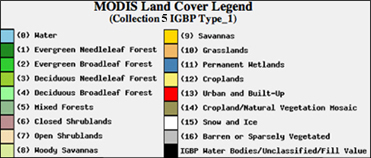| Salisbury, MD |
| Return to Regional/National map |
| County: Wicomico |
State: MD |
|
| Active Since: 2008 |
Observer: |
| Lat/Long: 8.3, -75.6 |
Landsat WRS Path/Row: 14/33 |
| MODIS TIle V/H: 5/12 |
MODIS Line, Samp: 194.32, 82.05 |
Site/Hive Description:
Half mile from Nanticoke Rd behind the UMD Lower Eastern Shore Research and Education Center (LESREC). Site is an old Christmas tree nursery surrounded on three sides by mixed deciduous forest. Fourth side open to research center. Elevation is 16 feet, flat terrain with sandy soils. Mixed nectar and pollen sources. Scale is new Northern Tool 1,000 lb capacity bench scale. 0.5lb increments. Leveled on a trailer, exposed to weather. Hive was started with new 2 lb package of Italian bees with queen (Wilbanks), with one deep. Fed and expanded as needed during seasons.
|
|
|
|
MODIS Subset Data (from the ORNL DAAC)
Red dots are the average of all pixels with acceptable quality (see landcover extract below for area covered).
Blue dots are the center pixel only (point is not plotted if the pixel is of unacceptable quality). |
| | | |
| NDVI The Normalized Difference Vegetation Index (NDVI) is the ratio of the difference between visible (red) and infra-red (IR) wavebands to the sum of these bands.
NDVI = nir - red / nir + red
NDVI provides an indication of the amount and vigor of vegetated surfaces.
NDVI has been widely used with multiple generations of satellite data.
|
 |
EVI
The Enhnaced Vegetation Index (EVI) is a more complicated combination of wavebands compared to the more widely used index, NDVI. The advantage of this newer index is improved sensitivity in high biomass regions and reduction in atmospheric influences.

where,
pNIR = NIR reflectance
pRed = red reflectance
pBlue = blue reflectance
C1 = atmosphere resistance red correction coefficient
C2 = atmosphere resistance blue correction coefficient
L = canopy background brightness
G = gain factor
|
|
The MODIS sensor on the Terra satellite platform provides us with 16-day composite measures of NDVI/EVI throughout the year. NASA distributes MODIS data from many of their distributed data centers.
|
|
|
|
MODIS Land Cover


MODIS Data Subset Citation:
Oak Ridge National Laboratory Distributed Active Archive Center (ORNL DAAC). 2007. MODIS subsetted land products, Collection 4. Available on-line [http://www.daac.ornl.gov/MODIS/modis.html] from ORNL DAAC, Oak Ridge, Tennessee, U.S.A.. |
|
| |
| |